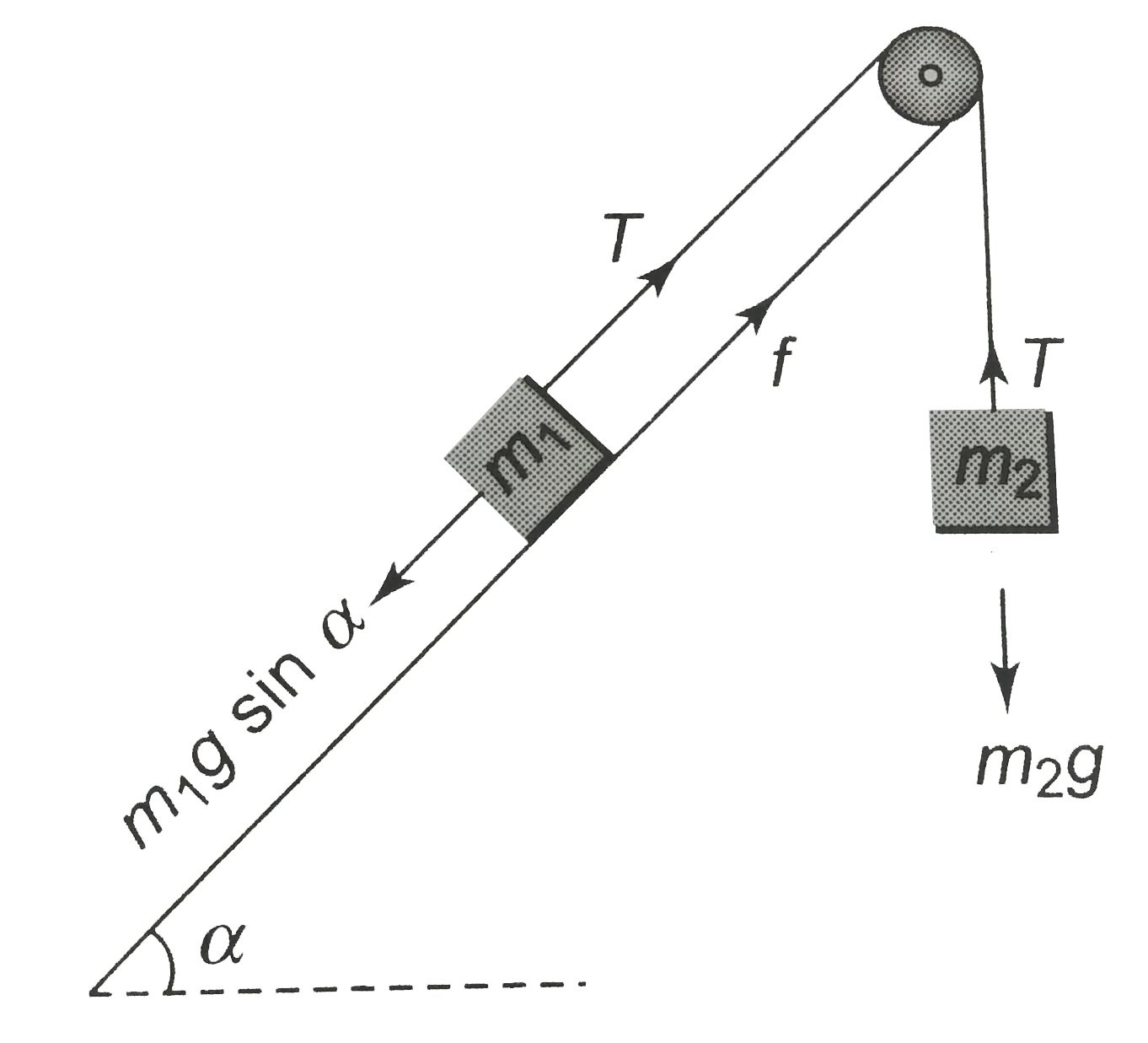Consider the situation as shown in the figure . The masses of pulley and the threads , as well as the friction in the pulley , are negligible. Assuming both bodies to be motionless at the initial moment. Find the mass ratio m1/m2 at which the body m2
(a) starts coming down
(b) starts going up
( c) is at rest

(a) m2 is coming down :
For m1:N=m1gcosα
f=μN=μm1gcosα
m2 will come down if
m2g>(m1gsinα+f)
⇒m2g>(m1gsinα+μm1gcosα)
⇒m2m1>(sinα+μcosα)
(b) m2 is going up
m1gsinα>(m2g+f)
⇒m1gsinα>(m2g+μm1gcosα)
⇒m1(sinα−μcosα)>m2
⇒m2m1<(sinα−μcosα)
( c ) m2 is at rest
(sinα−μcosα)≤m2m1≤(sinα+μcosα)
For m2 to be at rest:
Maximum value of m2=m1(sinα+μcosα)
Minimum value of m2=m1(sinα−μcosα)


Topper's Solved these Questions
Similar Questions
The following parameters of the arrangement of figure are available: the angle α which the inclined plane forms with the horizontal, and the coefficient of friction k between the body m1 and the inclined plane. The masses of the pulley and the threads, as well as the friction in the pulley, are negligible. Assuming both bodies to be motionless at the initial moment, find the mass ratio m2/m1 at which the body m2
(a) starts coming down,
(b) starts going up,
(c) is at rest.
 View Solution
View SolutionFind the acceleration of the block of mass m in the arrangement shown in the following figures. The masses of the pulleys and the threads, as well as the friction are assumed to be negligible.
 View Solution
View Solution
Knowledge Check
- Question 1 - Select One
In the arrangement shown in figure-2.124 pulley A and B are massless and the thread is inextensible. Mass of pulley C is equal to m. If friction in all the pulleys negligible, then :
 ATension in thread is equal to 1/2mgBAcceleration of pulley C is equal to g/2 (downward)CAcceleration of pulley A is equal to g/2 (upward)DAcceleration of pulley A is equal to 2 g (upward)
ATension in thread is equal to 1/2mgBAcceleration of pulley C is equal to g/2 (downward)CAcceleration of pulley A is equal to g/2 (upward)DAcceleration of pulley A is equal to 2 g (upward)
In the arrangement shown in the figure, the blocks have masses 3m,m and 2m, the friction is absent, the masses of the pulleys and the threads are negligible. Find the acceleration of mass 3m.
 View Solution
View SolutionIn the arrangement shown in figure the masses m of the bar and M of the wedge, as well as the wedge angle α, are known. The masses of the pulley and the thread are negligible. The friction is absent. Find the acceleration of the wedge M.
 View Solution
View SolutionConsider the situation as shown. The pulley has a moment of inertia I, and radius r, the block is in equilibrium. Find the time period of mass m. Assume no slipping.
 View Solution
View SolutionConsider the situation shown in figure. Both the pulleys and the strings are light and all the surfaces are frictionless. Calculate

(a) the acceleration of mass M,
(b) tension in the string PQ and
(c ) force exerted by the pulley P.View SolutionConsider the situation shown in figure. Both the pulleys and the strings are light and all the surfaces are frictionless. Calculate

(a) the acceleration of mass M,
(b) tension in the string PQ and
(c ) force exerted by the pulley P.View SolutionIn the arrangement shown in fig the bodies have masses m0,m1andm2 the friction is absent the masses of pulleys and the threads are negligible find the acceleration of the body m1
 View Solution
View SolutionIn the arrangement shown in figure the mass of body 1 is η=4.0 times as great as that of body 2. The height h=20cm. The masses of the pulleys and the threads, as well as the friction, are negligible. At a certain moment body 2 is released and the arrangement set in motion. What is the maximum height that body 2 will go up to?
 View Solution
View Solution
